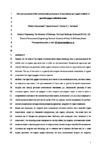Life cycle assessment of the environmental performance of conventional and organic methods of open field pepper cultivation system
| dc.contributor.author | Chatzisymeon, E | |
| dc.contributor.author | Foteinis, S | |
| dc.contributor.author | Borthwick, Alistair | |
| dc.date.accessioned | 2021-08-22T16:57:12Z | |
| dc.date.available | 2021-08-22T16:57:12Z | |
| dc.date.issued | 2017-06 | |
| dc.identifier.issn | 0948-3349 | |
| dc.identifier.issn | 1614-7502 | |
| dc.identifier.uri | http://hdl.handle.net/10026.1/17708 | |
| dc.description.abstract |
Purpose: As the scale of the organic cultivation sector keeps increasing, there is growing demand for reliable data on organic agriculture and its effect on the environment. Conventional agriculture uses chemical fertilizers and pesticides, whilst organic cultivation mainly relies on crop rotation and organic fertilizers. The aim of this work is to quantify and compare the environmental sustainability of typical conventional and organic pepper cultivation systems. Methods: Two open field pepper cultivations, both located in the Anthemountas basin, Northern Greece, are selected as case studies. Life cycle assessment (LCA) is used to quantify the overall environmental footprint and identify particular environmental weaknesses (i.e. unsustainable practices) of each cultivation system. Results are analysed at both midpoint and endpoint levels in order to obtain a comprehensive overview of the environmental sustainability of each system. Attributional LCA (ALCA) is employed to identify emissions associated with the life cycles of the two systems. Results are presented for problem-oriented (midpoint) and damage-oriented (endpoint) approaches, using ReCiPe impact assessment. Results and discussion: At midpoint level, conventional cultivation exhibits about threefold higher environmental impact on freshwater eutrophication, than organic cultivation. This arises from the extensive use of nitrogen and phosphorus-based fertilizers, with consequent direct emissions to the environment. The remaining impact categories are mainly affected by irrigation, with associated indirect emissions linked to electricity production. At endpoint level, the main hotspots identified for conventional cultivation are irrigation and fertilizing, due to intensive use of chemical fertilizers and (to a lesser degree) pesticides. For organic pepper cultivation, the main environmental hotspots are irrigation, machinery use, and manure loading and spreading processes. Of these, the highest score for irrigation derives from the heavy electricity consumption required for groundwater pumping associated with the fossil-fuel-dependent Greek electricity mix. Conclusions: Organic and conventional cultivation systems have similar total environmental impacts per unit of product, with organic cultivation achieving lower environmental impacts in ‘freshwater eutrophication’, ‘climate change’, ‘terrestrial acidification’ and ‘marine eutrophication’ categories. Conventional cultivation has a significantly greater effect on the freshwater eutrophication impact category, due to phosphate emissions arising from application of chemical fertilizers. | |
| dc.format.extent | 896-908 | |
| dc.language | en | |
| dc.language.iso | en | |
| dc.publisher | Springer Science and Business Media LLC | |
| dc.title | Life cycle assessment of the environmental performance of conventional and organic methods of open field pepper cultivation system | |
| dc.type | journal-article | |
| dc.type | Journal Article | |
| plymouth.issue | 6 | |
| plymouth.volume | 22 | |
| plymouth.publication-status | Published | |
| plymouth.journal | The International Journal of Life Cycle Assessment | |
| dc.identifier.doi | 10.1007/s11367-016-1204-8 | |
| plymouth.organisational-group | /Plymouth | |
| plymouth.organisational-group | /Plymouth/Faculty of Science and Engineering | |
| plymouth.organisational-group | /Plymouth/Faculty of Science and Engineering/School of Engineering, Computing and Mathematics | |
| plymouth.organisational-group | /Plymouth/Users by role | |
| plymouth.organisational-group | /Plymouth/Users by role/Academics | |
| dc.identifier.eissn | 1614-7502 | |
| dc.rights.embargoperiod | Not known | |
| rioxxterms.versionofrecord | 10.1007/s11367-016-1204-8 | |
| rioxxterms.licenseref.uri | http://www.rioxx.net/licenses/all-rights-reserved | |
| rioxxterms.type | Journal Article/Review |


